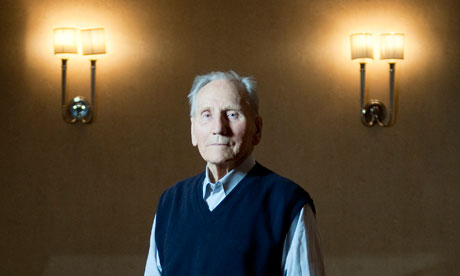 |
"Kazimierz Piechowski in 2011. 'We just planned that I would play the role of an SS officer so well that the guards would believe me.'" (Christian Sinibaldi/The Guardian) |
By Homa Khaleeli
The Guardian, April 11, 2011
"On 20 June 1942, the SS guard stationed at the exit to Auschwitz was frightened. In front of him was the car of Rudolph Höss, the commandant of the infamous concentration camp. Inside were four armed SS men, one of whom -- an Untersturmführer, or second lieutenant, was shouting and swearing at him. 'Wake up, you buggers!' the officer screamed in German. 'Open up or I'll open you up!' Terrified, the guard scrambled to raise the barrier, allowing the powerful motor to pass through and drive away. Yet had he looked closer, the guard would have noticed something strange: the men were sweating and ashen-faced with fear. For far from being Nazis, the men were Polish prisoners in stolen uniforms and a misappropriated car, who had just made one of the most audacious escapes in the history of Auschwitz. And the architect of the plot, the second lieutenant, was a boy scout, to whom the association's motto 'Be prepared' had become a lifeline. Almost 70 years later, prisoner 918 is holding forth in the home of the scouting association, Baden Powell House in London. At 91, he is impeccably dressed, with a face as wrinkle-free as his well-ironed shirt. As he accepts the ceremonial neckerchief from a shy girl scout from Lancashire, he is as straight-backed as any of the teenagers on parade. In the UK as the guest of a British singer, Katy Carr, who has written a song about his experiences, he is thrilled when the scouts and guides join her to sing for him. Yet in between the traditional trappings of a jamboree, Kazimierz Piechowski, or Kazik as he likes to be called, will tell them a story few in the UK have heard -- how, during Nazi occupation, scouts their age were murdered in the streets, while others like him were sent to concentration camps to witness the horror of Hitler's Final Solution. ... 'We were only the second transportation to the [Auschwitz I] camp,' Piechowski says, 'and we had to help build it.' The old collection of buildings that made up the original concentration camp was not big enough to house all those caught in mass arrests, so inmates were forced to work 12- to 15-hour days to construct a new camp next door that would become notorious as the Nazis' biggest death camp. ... For six weeks, Piechowski was set to work carrying corpses after executions. 'The death wall was between blocks 10 and 11. They would line prisoners up and shoot them in the back of the head.' At the end there would be a pile of naked corpses and Piechowski would take the ankles, while another man held the arms, and throw them on to carts, to transport them to the crematorium. 'Sometimes it was 20 a day, sometimes it was a hundred, sometimes it was more. Men, women and children.' He looks at me fiercely. 'And children,' he repeats. [...]"














No comments:
Post a Comment
Please be constructive in your comments. - AJ